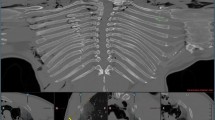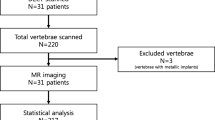Abstract
Purpose
The aim of this multi-reader feasibility study was to evaluate new post-processing CT imaging tools in rib fracture assessment of forensic cases by analyzing detection time and diagnostic accuracy.
Materials and methods
Thirty autopsy cases (20 with and 10 without rib fractures in autopsy) were randomly selected and included in this study. All cases received a native whole body CT scan prior to the autopsy procedure, which included dissection and careful evaluation of each rib. In addition to standard transverse sections (modality A), CT images were subjected to a reconstruction algorithm to compute axial labelling of the ribs (modality B) as well as “unfolding” visualizations of the rib cage (modality C, “eagle tool”). Three radiologists with different clinical and forensic experience who were blinded to autopsy results evaluated all cases in a random manner of modality and case.
Results
Rib fracture assessment of each reader was evaluated compared to autopsy and a CT consensus read as radiologic reference. A detailed evaluation of relevant test parameters revealed a better accordance to the CT consensus read as to the autopsy. Modality C was the significantly quickest rib fracture detection modality despite slightly reduced statistic test parameters compared to modalities A and B.
Conclusion
Modern CT post-processing software is able to shorten reading time and to increase sensitivity and specificity compared to standard autopsy alone. The eagle tool as an easy to use tool is suited for an initial rib fracture screening prior to autopsy and can therefore be beneficial for forensic pathologists.



Similar content being viewed by others
References
Leth PM (2009) Computerized tomography used as a routine procedure at postmortem investigations. Am J Forensic Med Pathol 30(3):219–222
Thali MJ, Yen K, Schweitzer W, Vock P, Boesch C, Ozdoba C, Schroth G, Ith M, Sonnenschein M, Doernhoefer T, Scheurer E, Plattner T, Dirnhofer R (2003) Virtopsy, a new imaging horizon in forensic pathology: virtual autopsy by postmortem multislice computed tomography (MSCT) and magnetic resonance imaging (MRI)—a feasibility study. J Forensic Sci 48(2):386–403
Ranschaert ER, Binkhuysen FH (2013) European teleradiology now and in the future: results of an online survey. Insights Imaging 4(1):93–102
Walz M, Dinter D, Weisser G, Reimann C, Bolte R, Düber C (2002) The future of teleradiology: results of teleradiology expert meeting of the health network congress 2001. Radiologe 42(2):113–118
Hong TS, Reyes JA, Moineddin R, Chiasson DA, Berdon WE, Babyn PS (2011) Value of postmortem thoracic CT over radiography in imaging of pediatric rib fractures. Pediatr Radiol 41(6):736–748
Livingston DH, Shogan B, John P, Lavery RF (2008) CT diagnosis of rib fractures and the prediction of acute respiratory failure. J Trauma 64(4):905–911
Schulze C, Hoppe H, Schweitzer W, Schwendener N, Grabherr S, Jackowski C (2013) Rib fractures at postmortem computed tomography (PMCT) validated against the autopsy. Forensic Sci Int 233(1–3):90–98
Love JC, Symes SA (2004) Understanding rib fracture patterns: incomplete and buckle fractures. J Forensic Sci 49(6):1153–1158
Yang KM, Lynch M, O’Donnell C (2011) “Buckle” rib fracture: an artifact following cardio-pulmonary resuscitation detected on postmortem CT. Leg Med (Tokyo) 13(5):233–239
Homann G, Weisel K, Mustafa DF, Ditt H, Nikolaou K, Horger M (2015) Improvement of diagnostic confidence for detection of multiple myeloma involvement of the ribs by a new CT software generating rib unfolded images: comparison with 5- and 1-mm axial images. Skeletal Radiol 44(7):971–979
Persson A, Lindblom M, Jackowski C (2011) A state-of-the-art pipeline for postmortem CT and MRI visualization: from data acquisition to interactive image interpretation at autopsy. Acta Radiol 52(5):522–536
Cattaneo C, Marinelli E, Di Giancamillo A, Di Giancamillo M, Travetti O, Vigano’ L, Poppa P, Porta D, Gentilomo A, Grandi M (2006) Sensitivity of autopsy and radiological examination in detecting bone fractures in an animal model: implications for the assessment of fatal child physical abuse. Forensic Sci Int 164(2–3):131–137
Ringl H, Lazar M, Töpker M, Woitek R, Prosch H, Asenbaum U, Balassy C, Toth D, Weber M, Hajdu S, Soza G, Wimmer A, Mang T (2015) The ribs unfolded—a CT visualization algorithm for fast detection of rib fractures: effect on sensitivity and specificity in trauma patients. Eur Radiol 25(7):1865–1874
Christe A, Flach P, Ross S, Spendlove D, Bolliger S, Vock P, Thali MJ (2010) Clinical radiology and postmortem imaging (Virtopsy) are not the same: specific and unspecific postmortem signs. Leg Med (Tokyo) 12(5):215–222
Sieswerda-Hoogendoorn T, Soerdjbalie-Maikoe V, Maes A, van Rijn RR (2013) The value of post-mortem CT in neonaticide in case of severe decomposition: description of 12 cases. Forensic Sci Int 233(1–3):298–303
Fischer F, Grimm J, Kirchhoff C, Reiser MF, Graw M, Kirchhoff S (2012) Postmortem 24-h interval computed tomography findings on intrahepatic gas development and changes of liver parenchyma radiopacity. Forensic Sci Int 214(1–3):118–123
Author information
Authors and Affiliations
Corresponding authors
Ethics declarations
The institutional review board approved this study in December 2014. The study was in full compliance with the Declaration of Helsinki in its current form.
Conflict of interest
The post-processing software for this study was provided by Siemens Healthcare (Forchheim, Germany). None of the investigators are employees of Siemens Healthcare.
Siemens Healthcare had no access to the image data and no control over the inclusion of imaging data, data analysis, and the manuscript.
The dkfz has a cooperation with Siemens Healthcare, Germany. This includes a specific collaboration agreement with the aim of a joint collaboration in the field of CT research in oncology as well as consultancies within the Siemens Advisory Board on oncologic imaging.
The Institute of Forensic Medicine Heidelberg has a cooperation with Siemens Healthcare, Germany. This includes a specific collaboration agreement with the aim of a joint collaboration in the field of forensic medicine with financing of research projects.
Rights and permissions
About this article
Cite this article
Glemser, P.A., Pfleiderer, M., Heger, A. et al. New bone post-processing tools in forensic imaging: a multi-reader feasibility study to evaluate detection time and diagnostic accuracy in rib fracture assessment. Int J Legal Med 131, 489–496 (2017). https://doi.org/10.1007/s00414-016-1412-6
Received:
Accepted:
Published:
Issue Date:
DOI: https://doi.org/10.1007/s00414-016-1412-6




